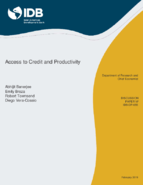Access to Credit and Productivity
Date
Feb 2019
Approaches to underdevelopment based on misallocation of resources have two premises. First, that there is huge heterogeneity in terms of underlying productivity among potential and actual entrepreneurs. Second, that the mechanisms that guide re-source allocation do not necessarily result in the resources going to the most productive entrepreneurs. Using the Townsend Thai data and the Million Baht program studied by Kaboski and Townsend (2012), we show evidence for both these premises. First, us-ing the fact that the Townsend Thai data include a long time series of pre-intervention information, we estimate TFP household by household. We then show that the elect of the Million Baht program, which was a source of additional short-term credit in the village, varies dramatically by pre-program TFP. There is no discernible elect in terms of income or business prots among low pre-program TFP households but the high TFP households show a large increase in prots (more than 1.5 THB increase in prots for 1 THB in loans). This elect doubles when we restrict to high TFP households that had a non-agricultural business before the intervention. On the other hand, program credit is not allocated based on baseline TFP. However market credit partly mitigates the disparity.



